 WE've MOVED
WE've MOVED
see new address and contact email in ABOUT US
improvisation, listening by Dave Knott
the following essay is a personal, historical, explanatory account of how I have come to improvise music using stringboards, what I am currently doing with it and where I hope to go with it. while not exhaustive, seeks to provide a context for how it plays in life as I perceive it.
It feels most natural to share this information in three voices. Each voice is an important part and it may be easier for a reader to frame the perspectives as separate. Therefore, each voice will be presented in its own font. The three fonts are:
Courier. This font carries text from the music therapy journal, a notebook from a student of music therapy who seeks to use latent musical talents to promote healing and growth. Sadly, it must also occasion to contain those sometime short falling attempts to describe the change that music can bring.
Georgia: The fool, j e s t e r..doesn't care to write complete sentances or even spell or punctuate correctly. Irresponsible by most "moral" standards and a complete amateur, truly too because he has no interest in anything but the sound of love -
Its many expressions in sound.
Chicago: The regulator, facilitator, the one trying to pull the group together. As the narrator, this font synthesizes and organizes the persona in some hopeful hope that any bit will make sense at all, much less some complex system of analyzing ideas and actions.
_____________________________________________________
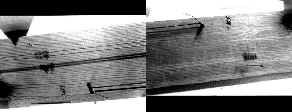 …
… … … …all stringboard … … … … … …
… … … … … … … … … … … … …
… … … … … … …photos are by Caterina de Carlo
___________________________________________________
…
… … … …all stringboard … … … … … …
… … … … … … … … … … … … …
… … … … … … …photos are by Caterina de Carlo
___________________________________________________
A vibrating string is truly a wonder. Plucked, bowed, strummed, slapped, touched, licked, dragged across the floor... We've all witnessed varied musical actions upon strings - and listened to the resultant tones.
The resonance of vibrating strings comes from many variables including the weight and shape of the string and the material.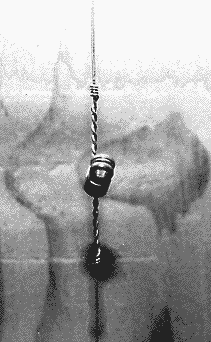 dkott, vibrating
string
dkott, vibrating
string
Internal, appreciable processes such as proper functioning of the ears (mechanical and neural) and psychological processing of auditory information as well as musical preferences of the listener and mental set all effect how one perceives sound. It is in this processing that the knowledge and inquiry of aesthetic and creative experience reside.
Improvising with sound has been of great interest for nearly all my life. Early memories of playing with parts of junk cars in my grandfather's salvage yard and tapping on and hollering into drainage pipes on the St. Mary's River remind me of this perpetual fascination with making sound and listening to it. I started playing guitar in 1981 and was the most at ease with it when plunking, picking, poking at it to see what sounds we could make together--free playing. Of course I wanted to learn how to "play" it so I bought the magazines, tablature books, took lessons when I could and went on to study classical and jazz guitar in college. All along I felt a sort of division between the free playing I did on my own and the music I did for class or performance--reserved playing. It wasn't until moving to Seattle in 1991 that I began to find individuals who embraced the presentation of their own free play as a performance medium. That was very exciting. Still though,
I often found in free improvisation with others a resurfacing of that reserved mind.I decided that I wanted to go a bit deeper into sound construction and in August 1994, I enrolled in the Roberto-Venn School of Luthiery. There I built a redwood/mahogany classical guitar, a fretless electric guitar and an electric bass. What I witnessed at R-V that was the most moving was recognizing music coming from the raw materials before the guitars were ever built. That was a profound discovery for me.
Upon returning to Seattle, I worked making harps and dulcimers at Dusty Strings Company and began playing more and more with musicians in the free way and in 1997, I began playing every Thursday night with Jeph Jerman and Aaron Wintersong at the Anomalous records performance space.
in that sense the growing, freedom to move without fear.. knowing a vigil has been set. a day of play and nothing but. repetition, cylindrical pulse, a frequency in time we rode.
.that may be a key in the interaction 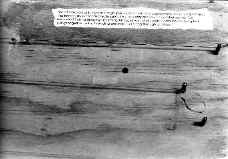
During this time I had access to a wood shop and was experimenting with attaching strings to pieces of found plywood--really a combination of an interest in finding new sounds and
an obsession with putting strings on boards and manipulating/attaching/ preparing the strings in ways that made very un-string like sounds--strings tied together, strings joined by springs, plucking, strumming and bowing as well as using percussive techniques and the application of secondary materials such as rocks from the parking lot, sticks and twigs as bridges, door knobs as bridges.. Exploring with my woodshop mate Peter Bonnell, we discovered a simple and astounding preparation by using ball-end guitar strings, one threaded through the end of the other.
Acoustic deviations of the string--material composition, length, its resonating surface (soundboard), and the properties of the space in which it is played (acoustics and noise)--effect the quality of the string's tone. When the composition of the string is altered or manipulated, such as introducing an object onto the string (Cowell, Cage), altering or building the instrument to affect the string (Partch), or using specialized techniques to elicit string vibration (Fullman), new sonorities are evoked.
These sonorities may lead listeners to different experiences than the traditional sounding of strings.the boards and strings, found things, but played with care and appreciation. a wall of sound hanging suspended upended
process of reward and freedom, perception - interpretation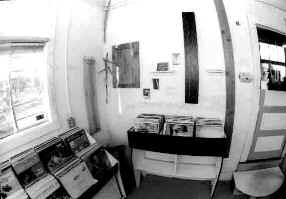
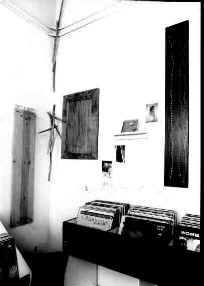
Wall of Sound installation: Seattle, Washington
Anomalous' owner Erik Lanzillotta asked if I would make an installation of stringboards and I gladly agreed. Strings of all manner mounted to collected pieces of wood provided the primary materials for its construction.
Unassisted stringboard making requires certain physiological skills such as gross and fine motor skills. Carefully guiding and turning a tuning pin into place is a complex task requiring hand-eye coordination, depth perception, sense of self in space, and other physiological skills. In addition to physiological skills, psychological skills are developed such as attention and focus, problem solving, aesthetics, formulating opinions and acting upon them, self development, and growth.By mounting the boards to the wall, the wall became a secondary resonator for the instruments--in effect the room became the instrument. Putting strings on the walls was born of this weekly conspiracy. A gathering of wills to conspire a unity of expressed sounds. (Clicks, sproinks, booweeps, and puuoouush's abound played across into and with everyone else, everything else).
Placed on one's head or across body parts, I can feel the pulse of the vibrations setting in sympathy parts of my body--I begin vibrating with the string, just like the wall did.
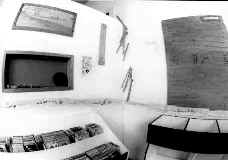
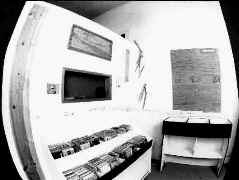
I was also interested in a tuning system based upon an individual's subjective experience of when the string in question "sounds" properly tuned. This engages the tuner to listen to that string on that piece of wood and focus their attention on the resonance of that moment.
Tuning:
Listening to the sound of the string, I tune each one to its most clean and projecting resonance. The prepared strings, ball-end style, seem to have a range of tension where the sound is most brilliant. When plucked it produces a mysterious cymbal or bell like sound rich in harmonics. As two strings are used, often two different fundamental tones are produced in the single vibrating length. The combination of tones and overtones playing with itself is both chaotic and natural sounding.
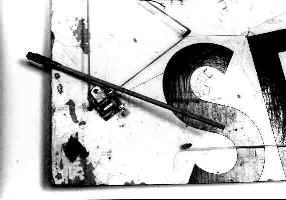
Stringboards are tuned according to the tuner's discretion, listening carefully for each string's most appreciated resonance. Above all else, string preparations require a player to observe and act, tuning to enough tightness to make it sound yet not so much that it breaks. This is a high functioning, fine motor task that requires the participant to involve themselves aesthetically. Since there is no prescribed pitch for tuning, only an aesthetic quality of resonance, the participant must engage themselves in an active way. In addition to the tension part of tuning is preparing the string: How long it will be? What combination of guage and string type are to be used?
These types of actions - musical action - require creativity, decision - making, and expressions of self. By listening for the desired tone while adjusting the tension of the string, a participant is engaging gross and fine motor and coordination skills as well as making aesthetic decisions about when they feel the string is most resonant.
Declaring ANY sound to be the most resonant is a statement of self, an expression of belief.
Meaning is given to the tuned string in the form of appreciation and action. 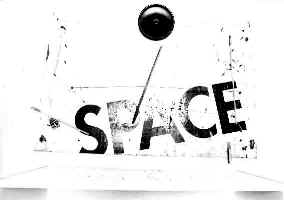
As we played every Thursday night at the same location, I became more aware of the sound of the city; an opening or deeper perception of the environment came into focus.
The ding and tick of the crossing bell, screeching and rushing autos, clattering passersby. More than one person wandered into the session, and helped themselves to the instruments. ON many levels, it seemed as though at our best our playing was a genuine accompaniment to the sound of the environment. The environment pressed into the music-demanded its space--our attention.And at my best feeling they and it playing me--have
been reclaimed by the moment, surrendered to sound."Then there is the whole branch of exploring acoustic phenomenon."
In July 1997, Erik Lanzillotta recorded the installation. A compact disc culled from that recording has now been released on Anomalous Records. The improvisation in full length provides a proper context for any one, isolated passage. When does sound, (nature) become perceived as music? When does one sound impress us with its presence while others pass by so unnoticed? How do we represent an entire sky with snapshots? What part of the presence of a musical experience can be recorded?
I decided to go study music therapy and got accepted by Willamette University in Salem, Oregon. I was there for two years intensely studying music therapy and during this time Eric and I worked on the process of getting the cd together. Very little composition was done to the material, mostly reduction of a 90 minute cassette recording to 73 minutes so it remains roughly as a document of improvisation and in this way reflects the listening that went on during the play at Anomalous. In addition, the cd presented an opportunity to collaborate with a dear old friend who happens to be an amazing realist painter, Russell W. Gordon. Russ wanted to make an original for the cd and I couldn't have been happier.
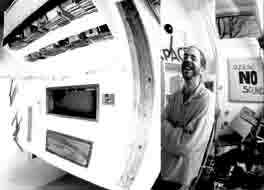
I am currently getting started with an internship in music therapy using music to help
individuals with HIV related health problems. Relaxation,
orientation to reality, and issues related to death and dying are areas of focus for the
use of music in this context. I've been using classical guitar (classical literature and
improvisation) and am having success. As I become more comfortable with the setting
and the residents more comfortable with me, I hope to involve the stringboards in the
process.
I have found a therapeutic context for the stringboards in my work with a 33 year old artist who sustained a brain injury in 1993. Besides singing, toning, and songwriting, we make stringboards together. First we find a suitable piece, he paints it then I install the tuning pins and string it up. We have begun creating soundscapes of the creative process by attaching a contact microphone to the board while he is painting and I am preparing. This forces us to work with a greater degree of interaction and cooperation and provides us with auditory feedback of what we are doing.
My plans now are to complete my internship and take the board examinations to become a
Certified Music Therapist. After that, I intend to build a stringed treehouse listening
sanctuary. Since I started putting strings on hunks of wood and hearing these wonderful
sounds, I've felt that the stringboard itself as an object is of secondary value, its
primary purpose is directing a listener's attention to the musical qualities of sound. And
(finally) beginning to recognize the importance of environment on musical experience, I
feel it necessary to head up into the trees with these ideas, strings and ears.
-dave knott